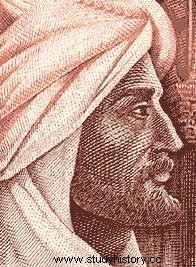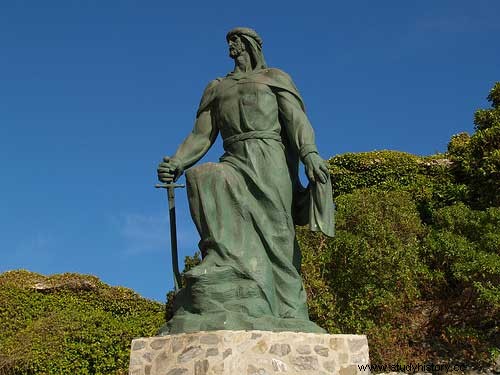The conquest of Hispania by the Muslims developed very easily, giving rise to the Emirate of Cordoba . Leaning on the Roman roads, Tariq and Muza, leaders of the invading Islamists, carried out, between the years 711 and 714, victorious incursions to the northern plateau and the Ebro valley, leaving garrisons at key points. In truth, they hardly encountered the slightest resistance on the part of the Roman-Visigothic population. Moreover, many members of the Hispanic-Gothic nobility made an agreement with the invaders, as happened with an aristocrat from the Murcian region, named Teodomiro, who accepted the Islamic patronage "on the condition that no rule be imposed on him or on any of the his". It should not be forgotten that the Muslims were tolerant towards the Christians, who were, after all, «people of the Book» . It should also be noted that the Jewish minority, complaining of the persecutory attitude shown against them by the last Visigothic monarchs, helped the Islamic invaders.

Disputas at the beginning of the Emirate of Cordoba
In any case, disputes were not lacking within the victors, whether it was the struggle between the Arabs and the Berbers or between the various factions of the Arab aristocracy, the Qaysíes and the Yemeníes. Precisely a few years after the Islamic presence in al-Andalus, a spectacular uprising took place among the Berbers, who felt discriminated against by the ruling Arab minority. In an attempt to quell this revolt, military reinforcements from Syria arrived in al-Andalus, which, once their mission had been completed, ended up settling on Hispanic soil, specifically in various districts in the south of the Iberian Peninsula. In spite of everything, in the first half of the 8th century the Muslims launched various offensive campaigns in the areas located to the north of al-Andalus. In the year 720 they conquered the city of Narbonne, which was in the south of Gaul, but in 722 they were surprised in Covadonga, in the mountains of Asturias, by the Christians. A few years later, in 732, they suffered a resounding defeat at Poitiers against the Frankish leader Charles Martel. That failure marked the end of the Islamist attempt to enter the territory of Christian Europe.
End of Dependent Emirate
The government of al-Andalus, which since 716 had the city of Córdoba as its center of power, was led by an emir, who obeyed the orders of the caliph, who was then installed in Damascus. Between 714 and 756, a phase known as that of the "dependent emirate" or Emirate of Cordoba, no less than twenty emirs succeeded one another in the government of al-Andalus . But in the middle of the eighth century there was a profound upheaval in the Muslim world. The Umayyads, a family in which until then the leadership of Islam and therefore the position of caliph had fallen, were violently eliminated by the Abbasids, who installed their power in the city of Baghdad. However, a member of the Umayyad family, who was able to escape the catastrophe, took refuge in Hispanic lands, managing, after a hard fight, to seize the emiral power of al-Andalus in the year 756. It was Abderramán I ( 756-788), with whom the stage of the "independent Emirate" began, so called because the emirs of al-Andalus had broken their relations with the caliphs of Baghdad, at least in the field of political action.

Consolidacióndelpoderislam
During the phase of the "independent Emirate" or Emirate of Cordoba, which lasted nearly two centuries, the power of Islam in Hispania was consolidated. Only the mountainous regions of the north of the Iberian Peninsula escaped the control of the Muslim emirs, where the people established there barely survived, whether they were members of the pre-Roman peoples of that territory (Galician, Asturian, Cantabrian, Basque, etc. ) or refugee Goths. Al-Andalus was incorporated into the economic system of the Islamic world, which offered undoubted advantages. At the same time, elements of Eastern social structures penetrated Hispanic lands. On the other hand, the number of Hispano-Novisigothic inhabitants, logically Christian, who accepted the Muslim religion, increased day by day, largely due to the tax advantages that this entailed. Likewise, the fluid communication maintained with the other countries of Islam allowed al-Andalus to participate in the extraordinary cultural wealth that circulated through them. A symbol of the firmness achieved by al-Andalus was, without a doubt, the main mosque of Córdoba, whose works began precisely in the time of Emir Abderramán I.
Internal Conflicts in al-Aldalus
Throughout the stage of the "independent Emirate" or Emirate of Cordoba, the Muslims carried out, on certain occasions, campaigns against the Christians of the north, whose main purpose was to prevent them from progressing towards the south. Most of these campaigns or aceifas penetrated through the upper valley of the Ebro. The clashes with the Christians were sometimes victorious for the Muslims, as happened, for example, in the year 856 in the battle of Morcuera; others were negative, such as the defeat suffered at Clavijo in the year 860. However, al-Andalus was also witness, at that stage, of important internal commotions. There were frequent conflicts between the central power, established in Córdoba, and the governors of the Marches, which were the border territories of al-Andalus, located around the cities of Zaragoza, Toledo and Mérida. But there were also tensions, basically of a social content, with the muladíes, a name given to converts to Islam, and with the Mozarabs, that is, the Christians of al-Andalus . The first symptoms of these conflicts appeared in the times of the emir Hisham I (788-796), who was the introducer of the Maliki doctrine in al-Andalus, which would end up becoming the orthodox version of Hispanic Islam. At the beginning of the 9th century, coinciding with the presence in the Emirate of al-Hakam I (796-821), there were serious revolts in al-Andalus. The first in time was the so-called "day of the Foso", which took place in Toledo in the year 807. A few years later, in 818, the so-called "riot of the Arrabal" took place , which alluded to the suburb of Secunda, in the city of Córdoba, and which was the object of fierce repression by the authorities.
ConflictwithlosMozárabesylosMuladíes

During the government of Emir Abderramán II (821-852), the conflict with the Mozarabs came to the fore. Some leaders of the Christian minority, including Paulo, Speraindeo and Eulogio, came out in defense of their own identity, to the point of perishing in the face of growing and unstoppable Arabization. The Mozarabic leaders even came to defend the opportunity of martyrdom against the pressure of the infidels. We cannot forget, on the other hand, that in the year 844 the Normans appeared on the coasts of al-Andalus, specifically in the vicinity of Lisbon and Seville. In the second half of the 9th century, coinciding with the emir Muhammad I (852-886), there were strong tensions between the emiral power and the Marches. The leader of the Extremaduran land mark, Ibn Marwan, el Gallego, a muladí, revolted, resisting with great bravery the attacks of the Cordovan troops. But perhaps the situation in the Aragonese region was more serious, at the head of which was the powerful family of the Banu Qasi, who descended from ancient Visigoth nobles converted to Islam. The strength reached by the Banu Qasi was such that a member of that family, Musa ibn Musa, came to be considered nothing less than the "third king of Spain". In any case, the most substantial revolt of the entire «independent Emirate» or Caliphate of Cordoba was the one initiated, in the year 879, by Umar ibn Hafsun, leader of the discontented Andalusian muladíes. A few years later, Umar ibn Hafsun converted to Christianity, which made him the leader of the Mozarabs of al-Andalus.
